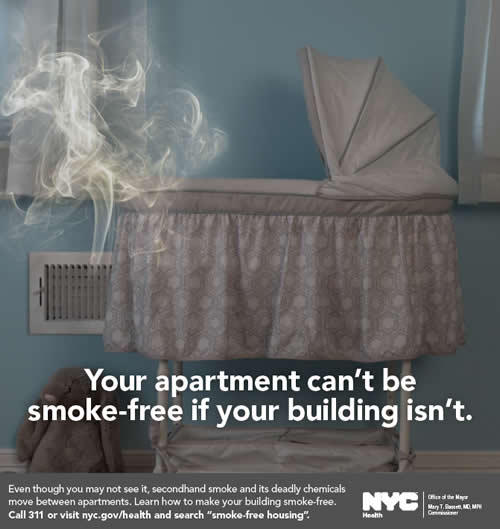4 Steps to Making Your Building Smoke-Free
In April of 2017 the Health Department launched a new media campaign educating New Yorkers on the dangers of secondhand smoke at home and encouraging them to make their home smoke-free. The media campaign ran through May 21 on bus shelters, in newspapers, on the Staten Island Ferry and on television. The video version of the campaign is available below.
Continuing the momentum of this campaign, smoke-free housing benefits everyone. For owners, there is less property damage and fewer turnover costs. Also, the lower risk of a fire can potentially lead to savings on insurance.
For residents, the air is cleaner and healthier in their homes, as well as in common areas, such as hallways, lobbies and stairwells.
Want to make your building smoke-free?
Here are 4 steps to get you started:
- Decide the policy. Do you want the entire building and all common areas to be smoke-free, or just apartments and indoor areas? You can involve residents in the process, possibly through a survey.
- Educate residents. Distribute a letter or notice to make sure everyone follows the new rules. This notice should include:
- Policy details
- Benefits of the rule
- Effective date
- Resources for quitting smoking
- Add the rule to leases. In addition to adding the rule to new leases, you can also amend current leases during renewal, or if a resident voluntarily agrees to a lease change.
- Enforce the rule. You should post signs, remove ashtrays and smoking litter, and start discussing the rule to prospective tenants.
For more information contact smokefree.housing@health.nyc.gov, visit nyc.gov and search “smoke-free housing,” or visit NYC Smoke-Free’s website: http://nycsmokefree.org/issues/housing-inequality.

 ximately 35 percent of New Yorkers report smelling smoke in their home coming from another apartment or outside. Adult non-smokers exposed to secondhand smoke have higher risks of stroke, heart disease and lung cancer. Children exposed to secondhand smoke have higher risks of asthma attacks, respiratory illnesses, middle ear disease and Sudden Infant Death Syndrome (SIDS). The media campaign will run through
ximately 35 percent of New Yorkers report smelling smoke in their home coming from another apartment or outside. Adult non-smokers exposed to secondhand smoke have higher risks of stroke, heart disease and lung cancer. Children exposed to secondhand smoke have higher risks of asthma attacks, respiratory illnesses, middle ear disease and Sudden Infant Death Syndrome (SIDS). The media campaign will run through 